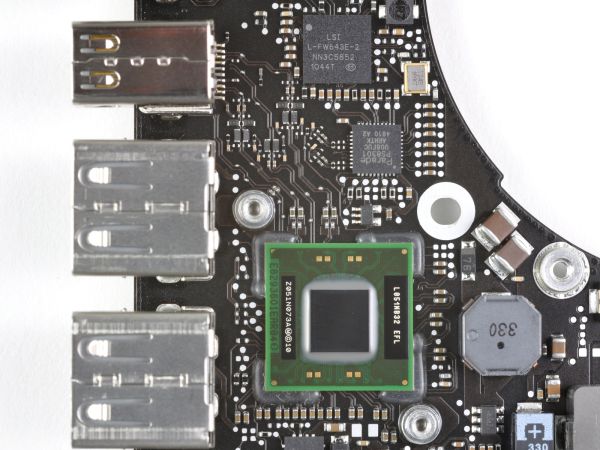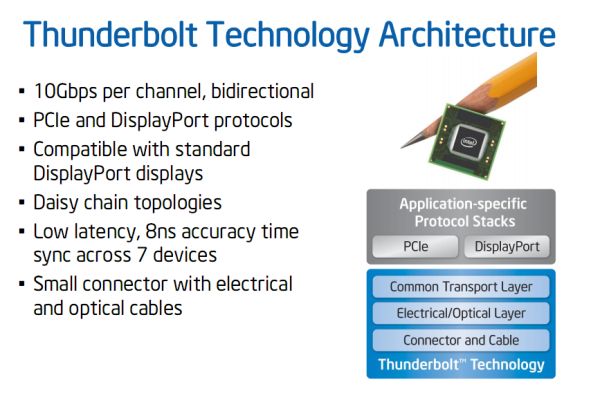Intel's Codename Light Peak Launches as Thunderbolt
by Brian Klug on February 25, 2011 1:10 AM EST- Posted in
- CPUs
- LightPeak
- News
- Thunderbolt
Back at IDF 2010, we wrote about Intel Light Peak nearing its eventual launch in 2011. Back then, the story was a 10 Gbps or faster physical link tunneling virtually every protocol under the sun over optical fiber. Though an optical physical layer provided the speed, in reality the connector and physical layer itself wasn’t as important as the tunneling and signaling going on beneath it. The dream was to provide a unified interface with enough bandwidth to satisfy virtually everything desktop users need at the same time - DVI, HDMI, DisplayPort, USB, FireWire, SATA, you name it. Daisy chain devices together, and connect everything with one unified connector and port. At IDF, we saw it moving data around between an Avid HD I/O box, a Western Digital external RAID array, and simultaneously outputting audio and video over HDMI. Intel also had another live demo working at over 6.5 Gbps.
That dream lives on today, but sans optical fiber and under a different name. Intel’s codename “Light Peak” is now named Thunderbolt. In addition, instead of optical fiber, ordinary copper does an adequate enough job until suitably cheap optical components are available. It’s a bit tough to swallow that optical fiber for the desktop still isn’t quite ready for mainstream consumption - issues like bend radius and the proper connectors were already mitigated - but copper is good enough in the meantime. Thunderbolt launched with the 2011 MacBook Pro, and though the interface isn’t Apple exclusive, will likely not see adoption in the PC space until 2012.
Although Thunderbolt in its launch instantiation is electrical, future versions will move to and support optical connections. When the transition to optical takes place, legacy electrical connector devices will work through cables with an electro-optical transceiver on the cable ends so there won’t be any need to use two separate kinds of cables. The optical version of Thunderbolt is allegedly coming later this year.
Thunderbolt shares the same connectors and cabling with mini DisplayPort, however Thunderbolt cables have different, tighter design requirements to fully support Thunderbolt signaling. DisplayPort is an interesting choice since it’s already one of the fastest (if not the fastest) desktop interfaces, topping out at 17.28 Gbps in DisplayPort 1.2 at lengths of under 3 meters. At longer distances, physics rears its ugly head, and throughput drops off over electrical links. Of course, the eventual advantages of moving to photons instead of electrons are greater distance without picking up much latency.
Thunderbolt is dual-channel, with each channel supporting 10 Gbps of bidirectional bandwidth. That’s a potential 20 Gbps of upstream and 20 Gbps of downstream bandwidth. The connection supports a daisy chain topology, and Thunderbolt also supports power over the cable, 10W to be precise. We aren't sure at this time what the breakdown on voltage/amperage is though.
Back when it was Light Peak, the goal was to tunnel every protocol under the sun over a common fast link. Multiplex everything together over one protocol-agnostic link, and then you could drop relevant data for each peripheral at each device in the daisy chain. Up to 2 high-resolution DisplayPort 1.1a displays and 7 total devices can be daisy chained. Thunderbolt instead carries just two protocols - DisplayPort and PCI Express. Tunnel a PCIe lane over the link, and you can dump it out on a peripheral and use a local SATA, FireWire, USB, or Gigabit ethernet controller to do the heavy lifting. Essentially any PCI Express controller can be combined with the Thunderbolt controller to act like an adapter. If you want video from the GPU, a separate dedicated DisplayPort link will work as well. Looking at the topology, a 4x PCI Express link is required in addition to a direct DisplayPort connection from the GPU.
Apple learned its lesson after FireWire licensing slowed adoption - the Thunderbolt port and controller specification are entirely Intel’s. Similarly, there’s no per-port licensing fee or royalty for peripheral manufacturers to use the port or the Thunderbolt controller. iFixit beat Anand and me to tearing down the 2011 MacBook Pro (though I did have one open, and was hastily cramming my OptiBay+SSD and HDD combo inside) and already got a shot of Intel's Thunderbolt controller, which itself is large enough to be unmistakable:
 Thunderbolt Controller IC on 15" 2011 MacBook Pro - Courtesy iFixit
Thunderbolt Controller IC on 15" 2011 MacBook Pro - Courtesy iFixit
In addition, you can still plug normal mini Display Port devices into Thunderbolt ports and just drive video if you so choose.
Though there aren’t any Thunderbolt compatible peripherals on the market right now, Western Digital, LaCie, and Promise have announced storage solutions with Thunderbolt support. Further, a number of media creation vendors have announced or already demonstrated support, like the Avid HD I/O box we saw at IDF.
Thunderbolt already faces competition from 4.8 Gbps USB 3.0 which has already seen a lot of adoption on the PC side. The parallels between USB 2.0 / FireWire and USB 3.0 / Thunderbolt are difficult to ignore, and ultimately peripheral availability and noticeable speed differences will sell one over the other in the long run. Moving forwards, it’ll be interesting to see Thunderbolt finally realize the “light” part of Light Peak’s codename, and exactly how that transition works out for the fledgling interface.















106 Comments
View All Comments
Shadowself - Friday, February 25, 2011 - link
Not meaning to be rude, but where have you been for the past 50 years in the computing technology world?You ALWAYS end up with drawers and boxes of old cables that are not the exact kind you need. It's just life.
MarshallG - Friday, February 25, 2011 - link
From the description here, it seems like the DisplayPort pins and the Thunderbolt pins are physically separate; they simply added pins to the DisplayPort connector/cable for Thunderbolt. This would explain why the connector is backwards-compatible with DisplayPort. It seems as though Apple and Intel are concealing this fact with marketing lingo, but it's obvious to me, at least, that the reports of Thunderbolt combining DisplayPort in its protocol are false.At any rate, I think most readers here are missing the key benefit -- it will be very easy to dock your MacBook. Because this is all based on DisplayPort and PCIe, there are many existing controller chips which could be put in a dock or inside a monitor -- SATA, second/faster graphics board, Gig Ethernet, and more USB ports. And this can probably be done with existing chips, or, at most, with only slight tweaks. I don't see this as a new protocol or standard; it's really PCIe in a cable, but that's a good thing.
thewhat - Friday, February 25, 2011 - link
USB is here to stay. Unless the plan is to give people Thunderbolt to USB converters (bad plan). USB devices are simply too widespread to be ignored. USB 3 is simply an evolutionary step we'd be silly not to take. There's even plenty of USB 3 storage out there already.OTOH, I think Thunderbolt offers some distinct advantages over USB and therefore could find its use for some high end applications.
The only problem I have with it is that it's too slow. Think of how awesome it would be to have powerful external GPUs etc.
So I think USB 3 and Thunderbolt will complement each other. Hopefully we'll now get rid of eSata, Firewire and perhaps even various video (and network) connections.
MarshallG - Friday, February 25, 2011 - link
There are no USB 3 drives. They are SATA drives with a SATA-USB 3 bridge. With this technology, you could attach a USB 3 or SATA drive, by having the right host controller on the other side of the cable. The cheapest and fastest way, I think, would be to put a SATA RAID chip on the other side of the cable.muzicman82 - Friday, February 25, 2011 - link
This looks very promising and I tend to trust it considering it was developed by Intel. I imagine at some point Intel will need to break away from Apple on development so that some things may be standardized.I understand that this is just a PCIe and DisplayPort link. However, for all of the various uses and protocols, it sounds like chipsets and controllers are going to need to be embedded in devices or cables for all of that backwards compatibility with Firewire, USB, etc that they claim.
It also seems like this will be quite expensive for some time.
I also think the technology needs to be made available on PCs for the industry to catch on. Or, even ExpressCard to Thunderbolt adapters for PC users may be adequate.
My hesitation right now is that 10Gbps is a burst theoretical claim. Unless you are connecting to a very fast RAID array that is truly 10Gbps internally, you're not going to see those kinds of speeds. Hard drives or SSDs are no where near that fast yet... so don't go out and buy that new Western Digital external drive that only has one or two drives in it. It's not going to be that fast.
I don't see a whole lot of benefit from having DisplayPort in the connector. Perhaps if you could put GPU's inside of displays, you might be onto something. The display's GPU could then send accelerated graphics back to your laptop LCD. Other than that, it seems like you would be paying for it to be there even if you didn't need that aspect of it. Maybe we'll see PCIe only Thunderbolt cables. I don't see a lot of benefit from daisy chaining devices either. It was there in Firewire and I never used that feature.
I would like to see an interface that pulls double duty and connects the same way externally as it does internally, providing both power and data.
glugglug - Friday, February 25, 2011 - link
In 8ns, light only travels 2.4m. Through copper it will go even less. So either the cable needs to be shorter than that (maybe 3 feet instead of 3m?) or the 8ns figure is wrong. Actually the 8ns is crazy anyway -- why would your external peripherals need lower latency than your RAM?jwilliams4200 - Friday, February 25, 2011 - link
Excellent point. And for some applications, the latency would be limited by a round-trip along the cable. Group velocity is likely only around 1x10^8 m/s. That would give a maximum cable length of 40cm (about 16 inches) for 8ns round-trip latency.darckhart - Friday, February 25, 2011 - link
1. didn't see in the article if it used one of the pcie lanes to do its deal. does it?2. it seems the apple implementation is severely neutered. why bother introducing it at all at this point in time? what do they expect it to do? link to (small) external storage? why bother? nothing really needs it currently. big external storage? you probably have it setup through the network on 10GbE. link to display? uh isn't that what the vga (for projectors or monitors) and hdmi (for tvs) currently does just fine?
Mech0z - Friday, February 25, 2011 - link
For people that think you need 16 PCI-E 2.0 lanes then your very wrong! Look at http://www.techpowerup.com/reviews/AMD/HD_5870_PCI...A HD5870 on x16 Pci-E 2.0 gets 24600 points in 3dmark 06 while it gets 23800 on x1 !
On average x1 gives 75% of the performance of x16 on pci-e 2.0
I use a Vidock and run pci-e 1.0 x1 (Only sandy bridge laptops have pci-e 2.0) and there you get 15000 in 3dmark06
Mech0z - Friday, February 25, 2011 - link
WhoopsI use a DIY Vidock http://forum.notebookreview.com/gaming-software-gr...